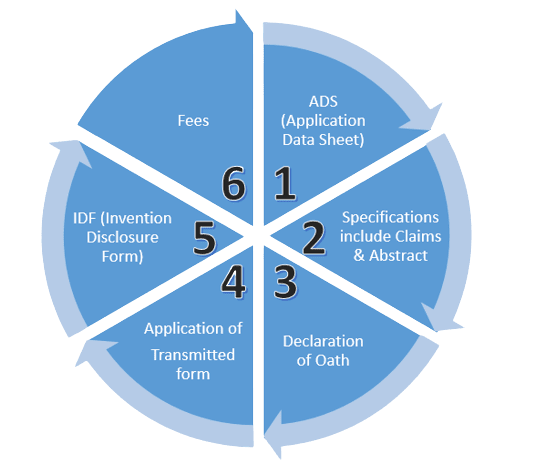Patent Filing
Services
We assist inventors and companies with the complex process of filing a patent application, providing a range of services from patentability searches to patent drafting and prosecution.
Benefits of choosing us as your Patent Attorney
Improve the chances of patent success by working around existing inventions
You can gain confidence in the patentability of your invention
Defend your patent
We will analyze patent results whether your invention is patentable
As a professional patent attorney we have 18 years experience in filing a patent applications and can save you time
Get Guidance for Do-it-yourself Patent Filing Search
- The process of submitting a patent application to the relevant government agency (such as the USPTO) to secure exclusive rights to an invention is known as patent filing.
- A patent grants the inventor the right to prevent others from making, using, selling, or importing the invention for a set period of time (usually 20 years from the filing date for a utility patent).
- Typically, the patent filing procedure includes preparing and submitting a detailed patent application that describes the invention and its distinguishing features.
- A patent examiner reviews the application and determines whether the invention meets the requirements for a patent.
- If the application is approved, the inventor is granted a patent, which protects their invention legally.
Different types of Patent Filings
Provisional patent application
A provisional patent application is a temporary filing that gives an invention an early priority date and permits the inventor to use the phrase “patent pending” for up to a year while they work on a more thorough application.
Non-provisional (utility) patent application
This is the classic method for a utility patent, which includes novel and helpful devices, tools, manufactured goods, and material compositions.
Design patent application
A design patent application covers novel, distinctive, and ornamental designs for manufactured goods.
International patent application (PCT)
With this application, an inventor can submit a single application to a single patent office in order to request patent protection across multiple nations.
Continuation patent application
A continuation patent application is one that is submitted by the same inventor(s) as an earlier application and maintains priority to the earlier application’s filing date.
Divisional patent application
A divisional patent application is submitted when a previously submitted application contains multiple inventions and the inventor(s) wish to pursue one or more of those ideas independently.
Continuation-in-part (CIP) patent application
A continuation-in-part (CIP) patent application is submitted when the inventor(s) wish to supplement a previously submitted application with additional information. Both the new material and the previously filed content are included in the CIP application.
Note: It is important to be aware that the patent filing process can be complex and time-consuming, and it is crucial to work with an experienced patent attorney or agent to ensure that the application is prepared and filed correctly.
CAN I DO A PATENT FILING MYSELF?
- A patent application typically includes a detailed description of the invention, along with any drawings or diagrams that may be necessary to explain the invention.
- The application must also include claims that define the scope of the invention.
- Once the application is complete, you can file it with the appropriate patent office. In the United States, this is the United States Patent and Trademark Office (USPTO).
- After filing the application, you will work with a patent examiner who will review the application and may ask for additional information or revisions to the claims.
- If the examiner issues an office action, you will need to respond to it within a specified period of time.
- If the application is approved, you will receive a patent, which gives you the exclusive right to your invention for a period of time.

SIMPLE STEPS TO FILE A PATENT ON YOUR OWN…
Search the United States Patent and Trademark Office
Before you invest another dollar or minute of your time, use this search engine to make sure your idea hasn’t already been patented. Make sure your idea is something you can patent using this resource from the USPTO.
Find a patent attorney
The application process can be made much simpler with the assistance of an experienced attorney, who can also help you avoid mistakes that could prove costly later on.
Determine what type of patent you need
Do you need a Utility, Design, or Plant patent? This will guide the process you’ll use to apply for the patent.
File a provisional patent application.
This offers a layer of protection in case someone later claims they had the idea before you did. U.S patent law is a first-to-file system, not first-to-invent. You have to move fast, or you’re screwed.
Become a Registered e-Filer
Gather information for your formal application
You’re going to prepare a specification, which includes an abstract, background, summary, a detailed description and conclusion. In addition, you’re going to define the scope of your patent and again. We advise you to use an experienced patent attorney. Unless, you’re 100% confident you have the skills and experience to handle this on your own.
Complete and review your formal application
It takes one to three years, on average, for a patent application to process. You don’t want it rejected for unnecessary errors or simple mistakes, so make sure you get it as close to right as possible the first time.
Participate in the patent process
Patent examiner assigned to your Patent case. If you receive any requests from them, respond as soon as you possibly can within the time period. Keep in mind that if you have an patent attorney, the USPTO will communicate directly with them, so you’ll need to get your updates there. You can help move things along faster by being proactive in communicating with the patent examiner; consider arranging an interview to address any of their concerns.
If your application is rejected twice, you can file an appeal with the Patent Trial and Appeal Board.
RISKS OF CONDUCTING YOUR OWN PATENT FILING

Lack of legal expertise
The patent filing process involves complex legal and technical issues that require specialized expertise. Without this expertise, there is a risk that the application may be rejected or result in a weakened patent that provides limited protection.
Inadequate patent search
A thorough patent search is critical to determine whether there are any existing patents or prior art that could affect the patentability of your invention. Without a proper search, you may waste time and money on a patent that is not likely to be granted.
Incomplete or inaccurate patent application
A patent application must be complete, accurate, and drafted in a specific format to be considered by the patent office. A mistake or omission in the application could result in a rejection or a weakened patent.
Difficulty in responding to office actions
If the patent examiner issues an office action, you will need to respond in a timely and appropriate manner. Without a deep understanding of patent law and the patent office’s requirements, it may be difficult to respond effectively.
Increased cost and time
If mistakes are made during the patent filing process, it can increase the cost and time required to obtain a patent. This could ultimately result in a delayed or weakened patent or even the abandonment of the patent application.
Protect Your Ideas
with
Affordable & Professional PATENT FILING SERVICES
Are you an inventor or entrepreneur with a unique idea? Do you want to protect your intellectual property and ensure that your idea is original? Then a patent search is an essential step in the patent process.
- As a patent attorney, I can understand the importance of protecting your intellectual property through patent filing. Filing a patent application can provide you with exclusive rights to your invention for a period of time, allowing you to prevent others from making, using, selling, or importing your invention without your permission.
- One of the key benefits of working with a patent attorney is expert guidance throughout the patent filing process. A qualified patent attorney has the knowledge and experience to help you determine whether your invention is eligible for patent protection and how best to describe and claim your invention. We can conduct a thorough search of existing patents and prior art to identify potential obstacles to obtaining a patent for your invention, helping you avoid the expense and disappointment of filing a patent application that is unlikely to be granted.
- Once we have determined that your invention is eligible for patent protection, we can help you draft a patent application that accurately and completely describes your invention and meets the requirements of the patent office. A well-drafted patent application can help avoid rejections and objections from the patent examiner, saving time and money in the long run. We can also help you develop a comprehensive intellectual property protection strategy that takes into account all of your potential rights, including patents, trademarks, and copyrights.
- If the patent examiner issues an office action, we can help you understand the issues raised and respond effectively to maximize your chances of obtaining a patent. We have the knowledge and experience to navigate the patent office’s requirements and respond to objections raised by the examiner, helping you obtain a strong and enforceable patent.
- Overall, working with a patent attorney can provide you with the guidance and protection you need throughout the patent filing process, potentially increasing your chances of obtaining a strong and enforceable patent. Contact us today to learn more about how we can help you protect your intellectual property.
Disadvantages of filing a patent without the support of a patent attorney
It is more advised to engage with a patent attorney for a stronger and more effective patent because filing a patent on your own without the assistance of a patent attorney can lead to mistakes, an increased risk of rejection, missed opportunities, a time-consuming procedure, and increased costs.
There are several issues to filing a patent without the support of a patent attorney:
- Lack of expertise: Patent law can be complex and confusing, and without the assistance of a patent attorney, you may fail to recognise important details or make mistakes that effect the validity of your patent.
- Increased risk of rejection: Patent examiners are trained to scrutinize patent applications and look for potential issues, which increases the risk of rejection. Without the help of a patent attorney, you risk failing to understand important details or making mistakes that could lead to your patent being rejected.
- Missed opportunities: A patent attorney can assist you in identifying opportunities to strengthen your patent application, such as additional claims or alternative wording. Without this assistance, you may give up the opportunities to increase your chances of success.
- Time-consuming: Filing a patent can be a time-consuming process that necessarily involves exhaustive research and attention to detail. You may need to spend more time on the process without the assistance of a patent attorney, which may take time away from other important tasks.
- Increased cost: While it may appear that filing your own patent would save money, the costs of making mistakes or having your application rejected can be significant. In the long run, hiring a patent attorney to help ensure that your patent is as strong as possible may be more cost-effective.
In short, while it is possible to file a patent on your own, working with a patent attorney is highly recommended to ensure that your patent is as strong and effective as possible.
